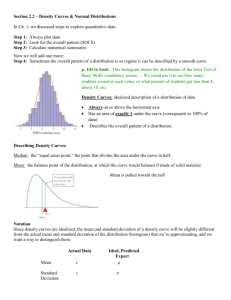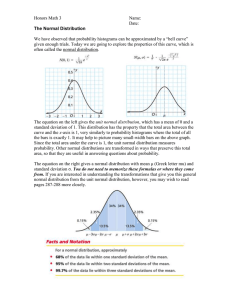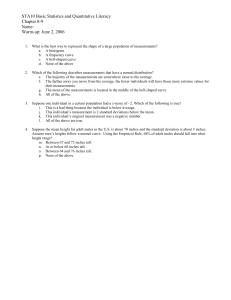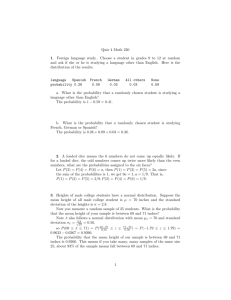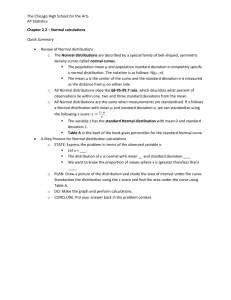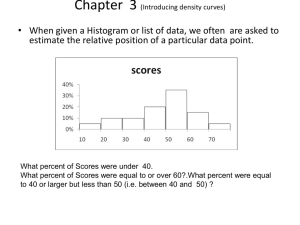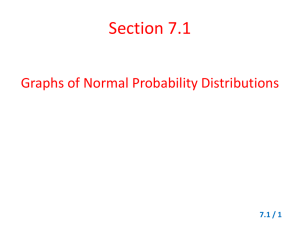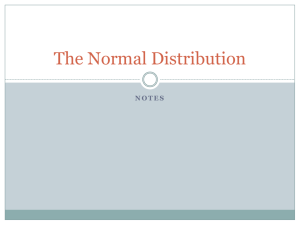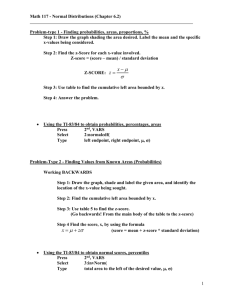More on Normal Distributions
advertisement
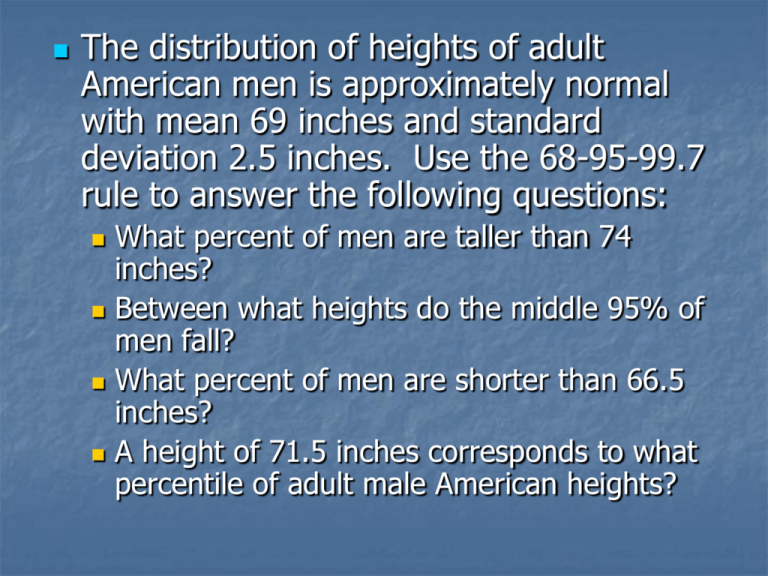
The distribution of heights of adult American men is approximately normal with mean 69 inches and standard deviation 2.5 inches. Use the 68-95-99.7 rule to answer the following questions: What percent of men are taller than 74 inches? Between what heights do the middle 95% of men fall? What percent of men are shorter than 66.5 inches? A height of 71.5 inches corresponds to what percentile of adult male American heights? 2.2 More on Normal Distributions and Standard Normal Calculations Standardizing The standardized value is called a z-score. x is the given value. This tells you how many standard deviations you are from the mean. This also allows you to find the percent of data under a given part of the curve. z x Who’s Taller? (relatively speaking) Verne is 67” tall. Assume the heights of women her age are normally distributed with a mean μ = 64 inches and standard deviation σ = 2.5 inches. Hank is 72” tall. Assume the heights of men his age are normally distributed with a mean μ = 69.5 inches and standard deviation σ = 2.25 inches. Example The score for each student on a quiz is determined and a histogram is created from the data. It is bell-shaped and symmetric with a mean of 80 and standard deviation of 10. Interpret a zscore for a student who scored a 87 on the quiz. Standardized Normal Curves Recall our formula for standardizing normal curves. z x Since any normal curve can be standardized, we can find areas under the curve using one table, Table A. This table is found in the front of your book or in your folder. Table A It is very important to remember that Table A gives the area under the curve to the LEFT!!! Also, standardized normal curves have a mean of 0 and a standard deviation of 1. Reading Table A Use Table A to find the proportion of observations that have a z-score less than 1.4 (this is 1.4 standard deviations from the mean). Find the hundredths digit across the top of the table. In this case, the hundredths digit is 0. Find the ones and the tenths The answer is in the digits intersection: this .9192 column. P(Z<1.4)=.9192 Reading Table A: “Greater Than” Problems Use Table A to find the proportion of observations greater than a z-score of -2.15. Table A gives us .0158 for the area to the LEFT. We want the area to the RIGHT (greater than -2.15), so subtract from 1. P(Z>-2.15) = 1-.0158 = .9842 Steps in Finding Normal Proportions Step 1: Draw a picture of the distribution and shade the area of interest . Label the curve with the values given (center and important points). Step 2: Standardize x by using the formula. z x Label your picture with the standardized values. Step 3: Use Table A to find the area under the curve. Step 4: State your conclusion in words in the context of the problem. Now to the actual problems… A commonly used IQ “cut-off” score for AIG identification is 125. IQ scores on the WISC-IV are normally distributed with a mean = 100 and a standard deviation = 15. Find the proportion of people whose IQ score is at least 125. “Between” Problems IQs between 140 and 170 are commonly referred to as “moderately profoundly gifted.” What proportion of the population have IQ scores between 140 and 170? Working Backwards Scores on the SAT Verbal approximately follow the N(505,110) distribution. How high must a student score to be in the top 10% of all students taking the SAT? Caution about Test Items Many test items ask students to distinguish between types of density curves. Once the hear the word, students have a tendency to call everything “normal.” Be careful! Density Curves Skewed Bimodal – Two peaks… Looks kinda like a camel Just because a curve is symmetric, has one peak and is bell shaped does not mean it is a NORMAL curve!!! Symmetric Unimodal Bell Shaped Normal Curves 68-95-99.7 Rule What if they don’t tell me whether the data are from a normal population? If you’re given the data, you have several ways to assess normality. Start by looking at a histogram, stemplot, dotplot, or box-and-whisker plot. Does the data appear symmetrical, with most of the data being near the center? And of course there is always the Empirical Rule… Another method is to check the 68-95-99.7 rule. First, find the mean and standard deviation. Then count what percent of the observations fall within one standard deviation of the mean. Is it close to 68%? Repeat for 2 and 3 standard deviations away from the mean. Normal Probability Plots Another (and easier ) method is to construct a normal probability plot using your calculator. If the plot is approximately linear, it is safe to assume the data are from a normal distribution. Constructing Normal Prob. Plots Type your data in your calculator (it is probably already there, because I know you have looked at your histogram or boxand-whisker plot!). Go to StatPlot. Choose the last graph option. This represents Normal Probability. Lets see what we can come up with! Let’s look at the example on page 125 Homework Chapter 2#53-56, 60
